
A slot antenna consists of a metal surface, usually a flat plate, with one or more holes or slots cut out. When the plate is driven as an antenna by an applied radio frequency current, the slot radiates electromagnetic waves in a way similar to a dipole antenna. The shape and size of the slot, as well as the driving frequency, determine the radiation pattern. Slot antennas are usually used at UHF and microwave frequencies at which wavelengths are small enough that the plate and slot are conveniently small. At these frequencies, the radio waves are often conducted by a waveguide, and the antenna consists of slots in the waveguide; this is called a slotted waveguide antenna. Multiple slots act as a directive array antenna and can emit a narrow fan-shaped beam of microwaves. They are used in standard laboratory microwave sources used for research, UHF television transmitting antennas, antennas on missiles and aircraft, sector antennas for cellular base stations, and particularly marine radar antennas. A slot antenna's main advantages are its size, design simplicity, and convenient adaptation to mass production using either waveguide or PC board technology.

The Murasame-class destroyer is a class of destroyers, serving with the Japan Maritime Self-Defense Force (JMSDF). This is the first class of the second-generation general-purpose destroyers of the JMSDF.

The Asagiri-class destroyer is a class of destroyer, serving with the Japan Maritime Self-Defense Force (JMSDF). It was the second class of first generation general-purpose destroyers of the JMSDF.
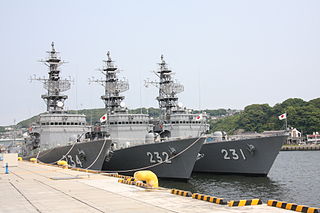
The Abukuma-class destroyer escort is the general-purpose destroyer escort of the Japan Maritime Self-Defense Force. It is the successor of the earlier Yūbari class.

Type 81 Fire Control System (FCS-2) is a Japanese shipboard gun and missile fire-control system. This series of systems has been installed on destroyers of the Japan Maritime Self-Defense Force built between FY1977 and FY2001 to control medium-caliber guns and Sea Sparrow missiles, including ESSM.

FCS-3 is an integrated naval weapons system developed by the Japanese Defense Ministry for the Japan Maritime Self-Defense Force.

JS Kurobe (ATS-4202) is a training support ship of Japan Maritime Self-Defense Force.
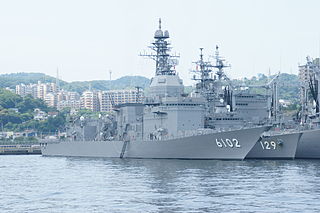
JS Asuka (ASE-6102) is an experimental ship of the Japan Maritime Self-Defense Force. The vessel was constructed by Sumitomo Heavy Industries of Tokyo, Japan and was launched on 21 June 1994. Asuka was commissioned on 22 March 1995 and since then has conducted performance confirmation tests for integrated navigation systems.

OPS-14 is a two-dimensional radar manufactured by Mitsubishi Electric. It is mainly mounted on the Maritime Self-Defense Force's self-defense ship as an anti-aircraft search radar. Variations include OPS-14B and OPS-14C.

OPS-11 is a two-dimensional radar manufactured by Mitsubishi Electric. It is installed as an anti-aircraft search radar on the Maritime Self-Defense Force's escort ship, and it will be the first model originally developed by Japan after World War II for this purpose. Variations include OPS-11B and OPS-11C.

OPS-18 is a two-dimensional radar manufactured by Japan Radio Company. It is installed as an anti-water search radar on the Maritime Self-Defense Force's escort ship. Variations include OPS-18-1 and OPS-18-3.
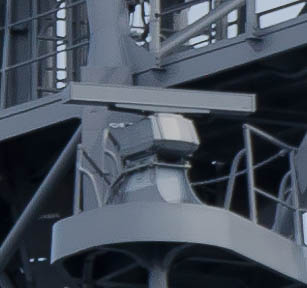
OPS-20 is a two-dimensional radar manufactured by Japan Radio. It is compatible with the Global Maritime Distress and Safety System (GMDSS) and installed as an anti-water search radar on the Maritime Self-Defense Force's escort ship. Variations include OPS-20B, OPS-20C and OPS-20E.

OPS-28 is a Pulse-Doppler radar manufactured by Japan Radio. It is installed as a low-altitude warning / anti-water search radar mainly on the Maritime Self-Defense Force's escort ship. Variations include OPS-28-1, OPS-28B, OPS-28C, OPS-28D, OPS-28E and OPS-28F.

AN/SPS-6 is a two-dimensional radar manufactured by Bendix and Westinghouse Electric. It was used by the US Navy as a first-generation air-search radar after World War II, and was widely exported to allies. In addition, the improved AN/SPS-12 is the derivative types developed in other countries.

OPS-4 is a two-dimensional radar manufactured by Oki Electric Industry. It was installed as surface-search radar on the Maritime Self-Defense Force's self-defense ship.

The Futami class was a class of oceanographic research ship of Japan Maritime Self-Defense Force (JMSDF) in the late 1970s.
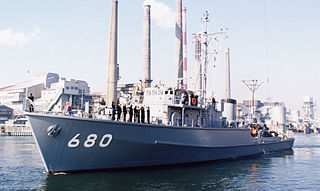
The Uwajimaclass is a class of coastal minesweepers of the Japan Maritime Self-Defense Force.

The Hatsushimaclass is a class of coastal minesweepers of the Japan Maritime Self-Defense Force.

AN/SPS-8 is a two-dimensional radar manufactured by General Electric. It was used by the US Navy as a height finding radar after World War II, and was equipped aboard naval ships during the Cold War. Variants include AN/SPS-8A, AN-SPS/8B, AN/SPS-8C and AN/SPS-8D After modernization, it was redesignated as AN/SPS-30.
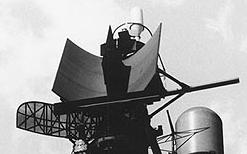
AN/SPS-39 is a three-dimensional radar was manufactured by Hughes Aircraft Company. It was used by the US Navy as a parabolic-cylinder reflector antenna after World War II, and was equipped aboard naval ships during the Cold War. It was mass-produced based on AN/SPS-26, and was also the first 3D radar deployed by the US Navy in the fleet. It later evolved into an improved AN/SPS-52.

![OPS-9 aboard JDS Teuri takamiXing Sao Hai Ting [teuri] .jpg](http://upload.wikimedia.org/wikipedia/commons/thumb/6/6a/%E3%81%9F%E3%81%8B%E3%81%BF%E5%9E%8B%E6%8E%83%E6%B5%B7%E8%89%87%E3%80%8C%E3%81%A6%E3%81%86%E3%82%8A%E3%80%8D.jpg/330px-%E3%81%9F%E3%81%8B%E3%81%BF%E5%9E%8B%E6%8E%83%E6%B5%B7%E8%89%87%E3%80%8C%E3%81%A6%E3%81%86%E3%82%8A%E3%80%8D.jpg)





















